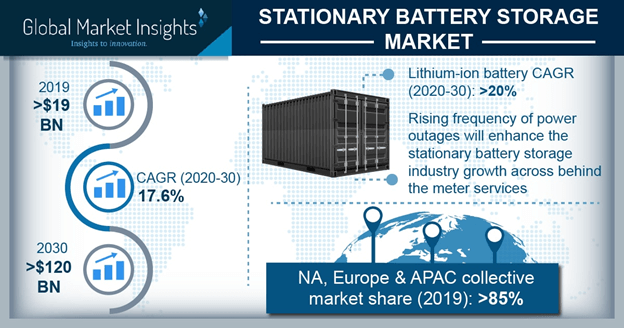Flow battery based stationary battery storage market to observe positive disruptions over 2019-2030, extensive investments across utility-based electrification systems to impel the industry growth
Publisher : Fractovia | Latest Update: 2019-03-06 | Published Date : 2017-07-28Request Sample
With grid-connected batteries christened to be an attractive business prospect, stationary battery storage market is likely to witness a major upswing over the forthcoming years. The newfangled wave of renewable power generation having hit the most industries, has left its impression on stationary battery storage industry as well. One of the major drivers that is responsible for the growth of this business space is the robust requirement of a sustainable electricity network pertaining to the clean energy demands across the globe.
Germany Stationary Battery Storage Market Size, By Battery, 2018 & 2030 (USD Billion)

This initiative is supported by the investments from various government and private organizations. In addition, stationary battery storage market is quite regulatory-driven, given that the product utilization, in a way, will have a profound effect on environmental safety. Global Market Insights, Inc., estimates stationary battery storage industry to surpass a revenue collection of USD 170 billion by 2030.
The competitive landscape of stationary battery storage market involves the participation of reputed biggies vying with one another to consolidate their business position. Product differentiation stands as the main criterion for these behemoths, for instance, Tesla’s launch of Powerwall, the rechargeable lithium-ion battery, in 2016, posed a heavy threat to industry participants back then.
Recently however, in response to Tesla’s Powerwall deployment in Australia, a Brisbane-based firm has declared the production of a residential battery named ZCell, forecast to be the dark horse infiltrating the battleground on which Tesla aims to secure triumph. The magnitude of stationary battery storage industry is thus, gargantuan, which is also quite evident from the competitive landscape of this market – according to a stationary battery storage industry report, the revenue share of this business is apportioned among the big-league enterprises such as GS Yuasa, Hitachi Maxell, Uniper, Koninklijke Philips, A123 Systems, ACDelco, Valence Technology, Durapower, Exide Technologies, Hitachi Chemical, Duracell, LG Chem, Tesla, Johnson Controls, Toshiba, Roofer Technology, Samsung SDI, BYD Co., and Panasonic.
The issue of energy crisis has now penetrated in most of the geographies across the globe. The Europe belt, in particular, has demonstrated an elevated level of aggressiveness when it comes to restricting the usage of fuels to contribute toward environmental safety. Regions such as UK, Germany, and France are thus, likely to stand out as potential business avenues for Europe stationary battery storage market. The European Commission has also initiated the Energy Efficiency Directive 2012/27/EU that assimilates the standardization of energy storage systems. Most of the battery manufacturing plants across the region comply with this regulation, thereby mapping a positive growth path for Europe stationary battery storage market.
Industry players across the globe have set their eyes on manufacturing unique products to be utilized across numerous end-use sectors. For instance, a renowned German energy company, EWE Gasspeicher, has recently declared its partnership with a university for constructing a huge flow battery in underground salt caverns that will be capable of supplying electricity to the capital city for 60 minutes. The company claims that this grid-tied battery, with a capacity of 120MW/750MWh, would be the largest flow battery in the world post its launch in 2023. This project is one of those instances that demonstrates the far-reaching scope of flow battery market, which held more than 6% of the overall stationary battery storage industry share in 2018. These batteries are utilized in a gamut of applications, with emergency power supply and uninterruptible power supplies (UPS) constituting a larger share.
The robust need to transform conventional grids to sustainable ones has led to a massive upsurge in the number of electrical network upgradation and grid refurbishment projects, which are certain to propel stationary battery storage market share. In fact, surveys depict that the emerging regions, with rapidly developing residential establishments will depict an increase in the number of refurnishing projects. Frequent grid failures at these places coupled with the extensive requirement for electricity will thus, collectively drive the demand for emergency power supply, setting the ground lucrative for stationary battery storage industry from emergency power supply.
Another lucrative product segment of stationary battery storage industry is the lithium ion battery, which is reputed to account for a widespread scope of real-time applications. Lithium ion batteries are extensively deployed for solar projects, uninterrupted power supply systems, reliable marine performance, portable power packs, surveillance systems, etc. Lithium ion battery market is anticipated to cross a valuation of USD 60 billion by 2024 – this growth is certain to propel the development of stationary battery storage market as well. In 2017, Tesla has launched its grid scale lithium ion battery of 129 MWh in South Australia, aiming for the establishment of effective grid storage technology on a large scale. Similar efforts undertaken by other reputed giants stand to contribute massively toward stationary battery storage industry size.
Despite having projected a fairly progressive graph, experts are of the opinion that the growth curve of stationary battery storage industry is not likely to remain stable on a global level. Possibly, the rationale behind this proclamation is the plethora of drivers fueling the trends of this business sphere. Elaborating further, experts insist that these drivers are certain to change massively as per the region, depending on myriad factors such as the infrastructure, regulatory landscape, and the electricity supply framework.
Other contributing factors that will have a profound effect on the regional stationary battery storage markets include energy demand trends, grid architecture network, population demographics, and the like. All in all, the general consensus declares stationary battery storage industry to exhibit immense growth potential, subject to global clean energy needs, while analysts claim this market to grow at a commendable growth rate over the coming thirteen years.